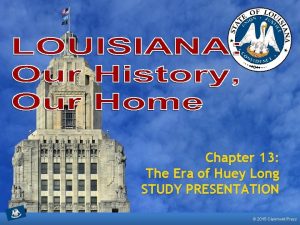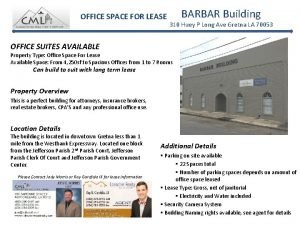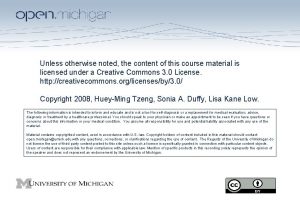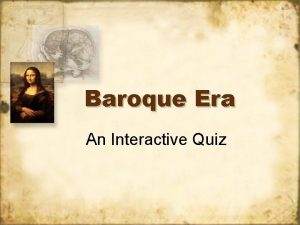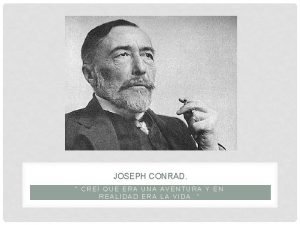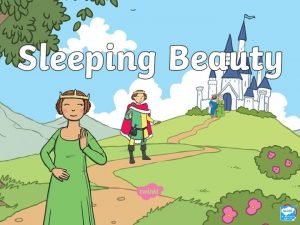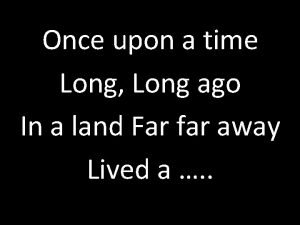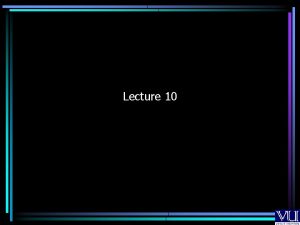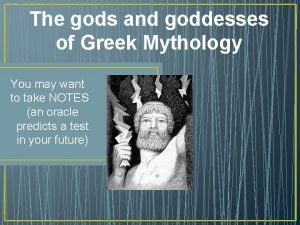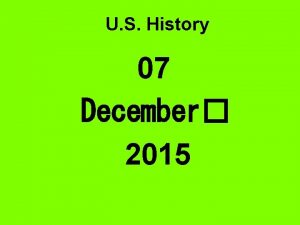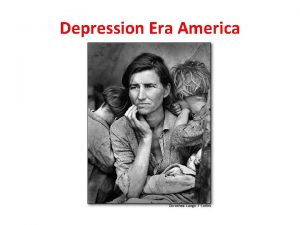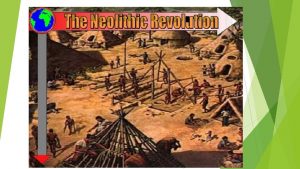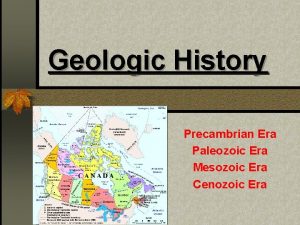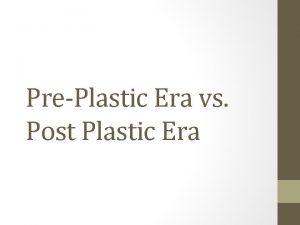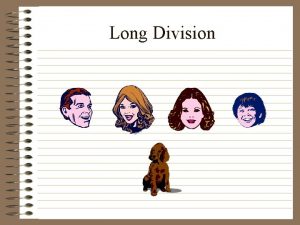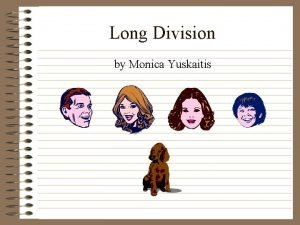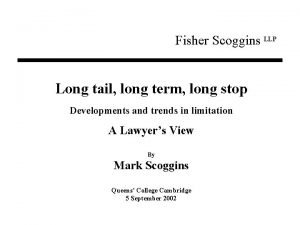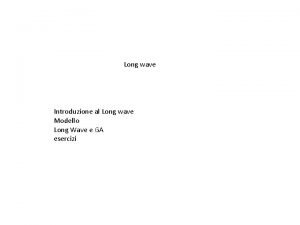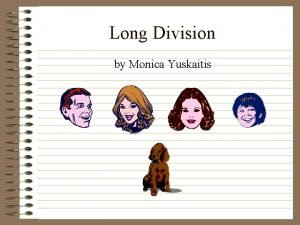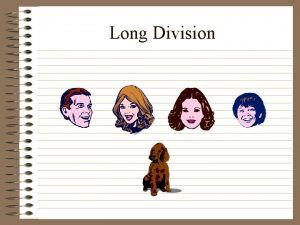Chapter 13 The Era of Huey Long STUDY





































- Slides: 37

Chapter 13: The Era of Huey Long STUDY PRESENTATION © 2015 Clairmont Press

Section 1: Politics of the 1920 s Section 2: Huey Long Elected Governor Section 3: Huey Long in the United States Senate

Section 1: Politics of the 1920 s Ø Essential Question: • How did the Flood of 1927 and prohibition lead to the popularity of Huey Long? 3

Section 1: Politics of the 1920 s Ø What terms do I need to know? • prohibition • Public Service Commission • Flood of 1927 4

Introduction Ø Ø Ø As the 1920 s began, many things changed, including the adoption of the Eighteenth Amendment, which outlawed both the manufacture and sale of alcohol. Louisiana supported prohibition, or forbidding by law the making and selling of alcoholic beverages. Communities had anticipated this and banned it years earlier, despite some unpopularity in the South. 5

Reforming Governors Ø Ø Ø John Parker was a member of the Progressive Party, organized by his friend Theodore Roosevelt. After losing the election for mayor in 1916, Parker joined the Democrats and won in 1920. Once in office, Parker was determined to continue implementing progressive reforms in Louisiana. After encountering issues with the 1913 Constitution, Parker called for a new constitution, which was adopted in 1920. He was praised for creating the severance tax, which made companies pay a percentage of the value of natural resources they took from the land. 6

Huey Long and the Railroad Commission Ø Ø Ø Huey Long’s successful law practice and record of helping the common man helped him when he ran for the Railroad Commission in 1918. In 1921, its name changed to the Public Service Commission, and Long won a seat on the threemember panel. In 1923, Long began his campaign to be governor, promising the statewide construction of modern, roads and bridges. Long also promised an improvement on the education program in the state. Despite high polls in the north, he lost the 1924 election due to low support in cities. 7

Ø Ø Ø The 1927 Flood Persistent rains throughout the Midwest and Mississippi combined with regular spring flooding created the Flood of 1927, which is one of the worst natural disasters in U. S. history. The Army Corps of Engineer’s attempt to use levees to hold back the flooding caused the water to overflow and made the flooding worse. In some places, the Mississippi River flooded more than 50 miles beyond its banks. Great Flood of 1927, New Iberia, LA Fatal Flood 8

The Citizens Flood Relief Committee Ø Ø Ø A group of business leaders created the Citizens Flood Relief Committee to protect commerce and the port in New Orleans. They decided that it was in the best interests of New Orleans to destroy the levees below the city, which would flood St. Bernard and Plaquemines Parishes. The Citizens Flood Relief Committee promised to provide payments and temporary housing for people who would be flooded. After receiving approval from the state, the officials used 33 tons of dynamite to open a large gap in the levees. More than 275, 000 people were forced from their homes by 1927 Flood. 9

1927 Flood 10

Political Impact Ø Ø Ø President Coolidge sent Herbert Hoover to assist with flood relief, which would contribute to Herbert’s presidential election victory in 1928. Huey Long also received a boost from the unhappiness caused by the flood. Long’s populist message, which focused on the needs of the common man, resonated with many people and helped Long become governor after the flood. 11

Section 2: Huey Long Elected Governor Ø Essential Question: • How did life change in Louisiana in the first years of Long’s first term as governor? 12

Section 2: Huey Long Elected Governor What terms do I need to know? Ø • • • bond deduct box fait accompli unorthodox misappropriate 13

Introduction Ø Ø Huey Long worked for four long years to improve his appeal with voters across the state. It was his hard work and message for the common people that made his election in 1927 a success. Huey P. Long was inaugurated governor in May of 1928, and began to enact his plans by any means necessary. The first promise Long tried to fulfill was the distribution of free textbooks. When Caddo Parish refused to take part in his plan, Long took the case to court, which would become one of his regular strategies. 14

Roads Ø Ø Long scattered paved road construction across Louisiana in hopes that at least use of small sections would make people want more of it. To fund this, they first used bonds, or certificates promising money at later dates for investments at the time. Governor Long put his friend O. K. Allen in charge of the Highway Commission, which was responsible for the projects. Progress was quick, however, the roads were often poorly paved and the program profited many of those involved personally, including Allen and Long. 15

Patronage Ø Ø Ø Long held a great deal of power with the public because of his control over state offices and jobs. Jobs were hard to find at the time due to an era of financial depression. With the ability to appoint people to mover 25, 000 state jobs, Long’s control of patronage appointments was ever more valuable. 16

The Deduct Box Ø Ø Long realized that state workers relied on him for their jobs, so he initiated the deduct box. The deduct box required state employees to give 10 percent of their salary back to the deduct box to support Long’s political organization. Long, however, frequently mixed deduct funds and campaign contributions with his personal funds. As a result, Long had vast amounts of money without any laws forcing him to disclose where the money came from or how he spent it. 17

Long and the Legislature Ø Ø Ø Long exercised his power by involving himself in every aspect of the lawmaking process. He constantly loomed over the legislative committees, making sure they did what he wanted. Long was even willing to achieve his goals without legislative approval. For example, Long received a loan from the State Liquidation Board to repair the governor’s mansion. Without waiting for legislative approval, Long had the mansion torn down, leaving the legislature with a fait accompli, or something that has been done and cannot be done. Afterward, seeking legislative approval became a mere formality. 18

Long and the Legislature – continued Ø Ø Ø Long’s opponents were learning that he was a formidable, unconventional, and unorthodox (different from what is usually done) opponent. Once, they attempted to impeach him on several charges, including misappropriating, or stealing, state funds. After fights in the House and bribery in the Senate, Long came out on top and even more in charge. 19

Section 3: Huey Long in the United States Senate Ø Essential Question: • What was Huey Long like as a US Senator, and what is his legacy? 20

Section 3: Huey Long in the United States Senate Ø What terms do I need to know? • Great Depression • Share Our Wealth program • grassroots support 21

Introduction Ø Ø Ø In 1930, Long won a seat in the US Senate but refused to be sworn in until he could control the election of his replacement as governor. Long helped his loyal friend O. K. Allen win the election for governor in 1932. Long, now calling himself Kingfish, then traveled to Washington, DC, where he was sworn into the U. S. Senate on January 25, 1932. 22

Senator Long Goes to Washington Ø Ø Ø Instead of deferring to other senators for advise according to tradition, Long followed a familiar pattern. He ignored, or found ways around, rules or people who got in his way. Long gave long speeches, and he also enjoyed filibustering because it blocked legislation he opposed and raised his profile among the electorate. 23

Broadening His Appeal Ø Ø Ø In 1932, Long took his campaign truck fleet, which was complete with loudspeakers to broadcast his message, to Arkansas to rally and give speeches in support of the reelection of fellow Senator Hattie Caraway, who was finishing her husband’s term. With Long’s help, Caraway won, becoming the first female Senator. By using her reelection as an example, Long was able to show the amount of power he had outside of his own state. 24

Louisiana during the Great Depression Ø Ø Ø By the time Long entered the Senate, the nation had suffered through the Great Depression for three years. The Great Depression was the name given to the economic downturn after the stock market crashed in 1929. Most rural and agricultural-based areas with farming families were hit hard economically. While they could normally grow enough to feed themselves, people in cities had no place for gardens. Many families ended up coming very close to starvation. 25

Share Our Wealth Ø Ø Ø During the Great Depression, Long’s populist message appealed to the poor, much like his messages after the Flood of 1927. Using the radio, Long listed his proposals for how to end the Depression and created his set of ideas called Share Our Wealth was a set of ideas, later a program, focused on making all Americans economically equal in order for all to have food, a house, and security in their old age. Share Our Wealth recording 26

Share Our Wealth – continued Ø Ø In a period of widespread economic distress, Long’s ideas were very appealing to much of the nation’s poor. Many Share Our Wealth societies sprang up around the nation, with more than four million members by 1935. Long’s final political step in his plan was to run for the presidency, and grassroots support, or support from ordinary people, certainly helped. He would regularly return to Louisiana to ensure his plans were being carried out by the state’s offices. Huey Long Newsreel: Louisiana's Kingfish 27

Public Works Ø Ø Ø Governor O. K. Allen continued the program of public words started when Long was governor. Long oversaw both new road and bridge construction in the state, as well as the drive for a new State Capitol building, which is still the tallest capitol building in the nation. However, Long found ways to cut corners in order for his programs to succeed. More than 3, 500 miles of paved roads were constructed during his first term, but they were narrower than the national standard by 4 feet. Also, many people were receiving kickbacks and payoffs. 28

Was Long a Dictator? Ø Ø This question actually does have some basis in fact, since he was serving as Senator, yet he still controlled the state’s government. There were many critics of Long’s dictatorial tactics, including many newspapers in Louisiana. Most critics were concerned that Long’s rising profile would spread these tactics if he became president. To prevent assassination, Long travelled with armed guards and created the Bureau of Investigation, a state police force under his control. 29

Long’s Final Days Ø Ø Ø Long announced his intention to run for president in 1936. As Senator Long was speaking with other legislators in the State Capitol and rounded the corner, young surgeon Carl Weiss approached. Many believe that he simply wished to confront Long about legislation regarding the removal of his father-inlaw, an anti-Long judge. Long’s bodyguards testified otherwise, stating that Weiss shot Senator Long point-blank. Long turned and ran for a nearby stairwell while his bodyguards riddled Weiss with sixty bullets, killing him instantly. 30

Long’s Final Days – continued Ø Ø Long was taken to the hospital, where the bullet was removed, but a nicked kidney kept bleeding internally. He died in the morning of Sept. 10, 1935, two days after being shot. Despite his many enemies and controversial reputation, his supporters regarded him as a hero for the common man. He was buried on the Capitol grounds, where, years later, a statue was place over the site representing his work. 31

Long’s Final Days – continued Ø Ø Ø At the time, few questioned Weiss’s guilt in Long’s death, making it an assassination. Recently, however, evidence has been reviewed and some questions arose. One note was that the gun used was not seen on Weiss’s person in crime scene photos and had an odd chain of custody. These and other issues raised the possibility that Weiss approached Long and the bodyguards opened fire, hitting Long by accident. No conclusive proof has ever been uncovered for this theory. Huey Long website 32

Long’s Successors Ø Ø Ø Even before Long’s burial, talk about succession in office began. Governor O. K. Allen planned on taking Long’s Senate seat, but died of a heart attack before he could take the seat. Long’s followers scrambled to find a suitable replacement, finally settling on Long-supporting, New Orleans judge Richard Leche. 33

The Louisiana Scandals Ø Ø Leche won the governor’s office easily in 1936, but many of the same corruption problems persisted and were still allowed. Unlike during Long’s corruption, however, federal investigations began digging into the levels of state corruption. By 1939, they had uncovered proof of the widespread corruption that characterized business in Louisiana. Such corrupt practices were later called “The Louisiana Way”. 34

The Louisiana Scandals – continued Ø Ø Ø In 1939, over 250 federal charges were filed against both Louisiana citizens and officials. Leche was forced to resign and was sentenced to ten years in prison for taking kickbacks. Other officials, including LSU President James Monroe Smith, served prison time for self-enriching misdeeds against the state and people. 35

Huey Long’s Legacy Ø Ø Ø Huey Long’s legacy was a mixed and controversial one. On the positive end, he drastically improved the transportation and education systems, as well as healthcare and governmental change. On the negative end, the cost of many of these projects was great, threats to freedom of expression, and self-enriching officials were regular. Lieutenant Governor Earl K. Long, Huey’s younger brother, was sworn in to finish Leche’s term. He used the same ideas and practices put in place by his brother into the 1940’s. 36

Image Credits Slide 1: Chris Miceli on Wikimedia Commons, Public Domain; Slide 2: Ken Thomas (alligator); Jillian. E (Chicot State Park); City of Monroe, LA; Albert Herring (Mardi Gras), Lael Butler (pelican); Jesper Rautell Balle (cajun meal); Susan Adams (Chemin-a-Haut State Park) on Wikimedia Commons; Image Credits Slide: Edd Prince on Wikimedia Commons; all others public domain Shown here: Fontainebleau State Park Return to Main Menu 37
 Chapter 13 the era of huey long
Chapter 13 the era of huey long 310 huey p long
310 huey p long Sara huey
Sara huey Unless otherwise noted meaning
Unless otherwise noted meaning Black panther 10 point program the hate u give
Black panther 10 point program the hate u give Short short short long long long short short short
Short short short long long long short short short Once upon a time lived
Once upon a time lived Từ ngữ thể hiện lòng nhân hậu
Từ ngữ thể hiện lòng nhân hậu Quiz 2 the baroque era
Quiz 2 the baroque era Victorian era vs elizabethan era
Victorian era vs elizabethan era Creí que era una aventura y en realidad era la vida
Creí que era una aventura y en realidad era la vida Vi uma estrela tão alta
Vi uma estrela tão alta Long long ago people used to think that the earth was
Long long ago people used to think that the earth was Once upon a time there was a king and queen story
Once upon a time there was a king and queen story Props in tinikling
Props in tinikling Once upon a time long long ago
Once upon a time long long ago Long long int c
Long long int c Greek
Greek Lông vằn lông vện mắt xanh
Lông vằn lông vện mắt xanh Once upon a long time ago
Once upon a long time ago Vua nào xuống chiếu dời đô
Vua nào xuống chiếu dời đô Hát kết hợp bộ gõ cơ thể
Hát kết hợp bộ gõ cơ thể Ng-html
Ng-html Bổ thể
Bổ thể Tỉ lệ cơ thể trẻ em
Tỉ lệ cơ thể trẻ em Chó sói
Chó sói Thang điểm glasgow
Thang điểm glasgow Hát lên người ơi alleluia
Hát lên người ơi alleluia Môn thể thao bắt đầu bằng từ chạy
Môn thể thao bắt đầu bằng từ chạy Thế nào là hệ số cao nhất
Thế nào là hệ số cao nhất Các châu lục và đại dương trên thế giới
Các châu lục và đại dương trên thế giới Công thức tiính động năng
Công thức tiính động năng Trời xanh đây là của chúng ta thể thơ
Trời xanh đây là của chúng ta thể thơ Mật thư anh em như thể tay chân
Mật thư anh em như thể tay chân 101012 bằng
101012 bằng Phản ứng thế ankan
Phản ứng thế ankan Các châu lục và đại dương trên thế giới
Các châu lục và đại dương trên thế giới Thơ thất ngôn tứ tuyệt đường luật
Thơ thất ngôn tứ tuyệt đường luật
